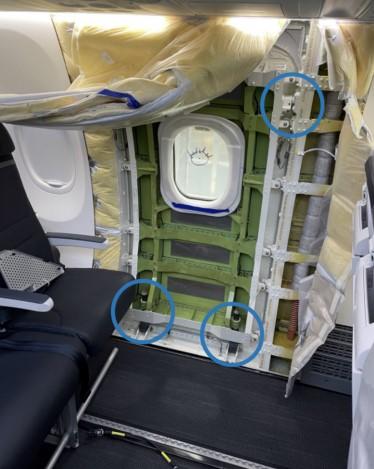The midair blowout last month of the left mid exit door plug on an Alaska Airlines Boeing 737 Max 9 jet should provoke a wake-up call for CEOs across multiple industries and federal government officials who provide safety oversight, not only the FAA. In the Alaska Airlines near-disaster, Boeing and government oversight officials dodged a bullet because nobody was killed.
The chair of the National Transportation Safety Board on Wednesday said there is a “quality control problem” at Boeing, one day after the NTSB issued a preliminary report finding that four bolts meant to secure the door plug appeared to be missing before the blowout occurred on Jan. 5.NTSB investigators said the absence of damage surrounding the holes where the bolts would have been located indicated that four bolts were missing. The Alaska Airlines plane in question had evidently flown dozens of flights without the bolts before the door plug blew out.

For now, the flying public is left gasping, “What, there were missing bolts in the exit door plug?”
Boeing CEO Dave Calhoun issued a statement saying the airplane manufacturer is “accountable for what happened” with missing bolts and the blowout. Good for him, but that may not be enough for the flying public.
NTSB Chair Jennifer Homendy went further than Calhoun in a CNN This Morning interview, saying NTSB is digging into the Boeing safety process—as well as the FAA oversight of Boeing. “There’s no way that this plane should have been delivered with four safety critical bolts missing,” she said. “There’s a problem in the process; we are digging in. We’re not just digging into what’s going on at Boeing, but we’re digging into [FAA] oversight of Boeing as well.”
She added that NTSB wants to understand Boeing’s quality management systems and “their safety culture.”
That’s comforting to a degree, but who oversees the FAA? Theoretically, the oversight comes from a larger government bureaucracy with accountability practices, including the Department of Transportation, but also from Congress, down to individual US Senators who sway enormous power in the US Senate Commerce Committee.
Last March, the chair of that committee, US Sen. Maria Cantwell, D-Washington, asked the FAA for greater transparency in its oversight of aircraft manufacturers and their suppliers. “For us, it’s making in the certification process…that another MCAS isn’t projected as part of the system and people don’t understand it.” MCAS, as many recall, was the flight control software fingered as largely to blame for two fatal 737 MAX 8 crashes that killed 346 people more than five years ago.
Update to more recently when Boeing’s Calhoun met with lawmakers Jan. 24. In a statement, Sen. Cantwell said, “The American flying public and Boeing line workers deserve a culture of leadership at Boeing that puts safety ahead of profits.” After that meeting with Calhoun, the Commerce Committee announced it will be holding an oversight hearing on the Alaska Airlines near-disaster and the NTSB findings in the matter.
Commerce Committee ranking member Ted Cruz, R-Texas, said the NTSB report included “disturbing details.. it is clear that a lot of work remains to correct Boeing’s production issues.”
For years, there have been worries that Boeing is “too big to fail,” a phrase attached mainly to banks that have received government assistance during times of crisis. As the main competitor to France’s Airbus, there is clearly a US interest in seeing Boeing thrive, but at what cost? Deteriorating relations between the US and China have shut out Boeing from its largest export destination, but Boeing also hurt itself in expensive fines and legal stumbles after the MAX crashes.
Fierce Electronics has reported on the FAA’s role in overseeing Boeing and its reauthorization of MAX 8 aircraft in six stories in recent years. Fierce noted that airline passenger rights nonprofit FlyersRights.org assaulted a court decision last year that kept secret the FAA’s oversight of the manufacturer. “Boeing and the FAA are now immune from review by outside independent safety experts, can shield negligence, incompetence, conflicts and undue influence in safety decision making,” Paul Hudson told Fierce in an email last August.
The essence of that Court of Appeals ruling June 30 was that FlyersRights and other groups are not allowed Freedom of Information Access to the MCAS discussions between FAA and Boeing because Congress has waived such access where the information involves “trade secrets and commercial or financial information obtained from a person and is privileged or confidential.” (Case number 21-5257)
Hopefully, Congress (and the Senate Commerce Committee) will see that keeping any secrets about Boeing’s safety culture or practices does not instill public confidence in government oversight agencies or important industry players. Hopefully, lawmakers see that the public has a right to know the full story of Boeing’s oversight of the Spirit subcontractor and other procedures that led to the door plug blowout. Achieving sunshine for the public may require a change to the FOIA law, but that seems unlikely.
More importantly, a wholesale review of how the federal government regulates all the industry players it oversees for safety may also be in order: Are medical instruments safe? Is our food supply safe? Are computer systems safe? Are the missiles made by subcontractors safe enough to get to the battlefield? Are bridges being built to remain safe? This safety concern will inevitably grow as the government weighs how it plans to oversee the development and regulation of artificial intelligence, especially. (Unfortunately, I have little faith the US government will develop meaningful regulation for AI safety and will instead wait for when the European Commission acts.)
For Boeing and some other industries, lawmakers need to seriously assess whether the practice can continue of allowing a company's own engineers to inspect that company's products.The concept makes sense if the in-house inspectors are highly qualified, but there are too many factors that can lead to missing faults in a product or system including a conscious or unconscious bias toward the party paying the paycheck.

Boeing’s actions before the Max 9 blowout surely bring into play a broad range of concerns about the interplay of a free market system, including the unfettered ability of companies to thrive and make profits, and government regulation for safety. For safety, who believes anybody can look the other way?
Gregory Travis, an unpaid expert for FlyersRights.org and a pilot and retired software entrepreneur, expressed outrage at how the public still has not learned exactly how a plane would respond if the current MCAS were to fail, owing to the protections granted in the Court of Appeals decision. “Can we even trust government to keep us safe?” he said last year.
More recently, Travis added: “Everyone and their pet cat cat could have seen this [door plug blowout] coming and the revelations now coming out of both Boeing and [fuselage supplier] Spirit Aerosystems are as horrifying as they were predictable. We seem determined as a species to have a tragic past and yet never do anything to learn from it.”